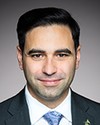Thank you very much, Mr. Chair.
I am happy to be here today to speak to you about issues related to development assistance from Canada. As the chair, Mr. Nault, said earlier, I am a professor at the University of Ottawa's School of Political Studies. I have been working on development assistance issues for at least two decades, and on Canadian development assistance for about 15 years. It is with pleasure that I will be sharing with you the results of my research and observations in the medium term, not to mention the long term.
I should also mention that I've written a number of publications on development assistance from Canada, including a chapter I sent to the clerk today. I don't know whether it will be possible to provide copies of it to MPs and committee members. I am also co-editor of several books on development assistance, the latest of which will be out in a few weeks. This second edition is entitled Rethinking Canadian Aid.
I'll be happy to send copies of the book to each and every one of you, if that would be welcome.
I'm very happy to be talking about the question of focus, because I think it's quite a red herring in foreign aid programs, and not just Canada's. I think there's too much emphasis being put on which countries and which sectors and on the idea that if we just get the countries right and we just get the sectors right, with the themes right, Canada or whatever country we're talking about will have a much more effective aid program.
There's actually no evidence that focusing on a smaller number of countries or themes increases aid effectiveness. I believe my colleague Lauchlan Munro will be talking about that. He has published on this point. He makes a very compelling case.
What I would like to say is that it introduces an element of “flavour of the month”. It's not quite “the month”, because it usually takes a few years for priorities to change. If we look at the Chrétien government, we see that they actually changed pretty frequently, often every time there was a new minister. A new minister would come in, and agriculture would be put on the list. Then the next minister would come in, and agriculture would come off and children would come on.
Even if we only revise our themes and our countries every few years, this introduces many elements that are actually contrary to aid effectiveness principles. One thing that is pretty obvious would be volatility or unpredictability and the perception that Canada cannot be seen as a reliable partner working with specific countries or working on specific themes.
It can also lead to over-concentration. If we're picking themes that are trendy internationally, then we're following the herd. We're spending money where everybody else is spending money and we're neglecting themes that are neglected by other donors.
In terms of countries, let me illustrate some of the quandary that Canadian aid has been in because of this rotating list.
Burkina Faso and Benin were introduced as countries of focus or development partners, depending on the terminology used at the time. They were added to the list in 2005. They had not previously been on the list. They were added in 2005, removed in 2011, and added again in 2014. I think you can understand that this is not a formula for effective aid or being a reliable partner.
Having a list of countries of focus also constrains us needlessly. It introduces new problems when something happens in a certain country and we don't wish to continue our aid there.
For instance, soon after Burkina Faso was re-added to the list in 2014, there was a coup, and Canada suspended aid. Recently Canada suspended aid to Mozambique, a country of focus, because of corruption; aid was suspended to Mali, a country of focus, because of a coup; and aid was suspended to Haiti, a long-standing country of focus, as well. This introduces a very unhealthy dynamic, if what we care about is aid effectiveness.
To me, the question of focus is mainly one of branding. It's, for one thing, to be able to say that “we”—Canada or the Canadian government, or quite often “we”, the political party in power—have this as our branded aid program: this is what we do.
I would say that this is in many ways very limiting. You heard from the previous witnesses about how it constrains countries in terms of lack of flexibility. If Ebola comes up and you're working in one country but not another, this hampers efforts.
The targets of having 75% or 80% or 90% of your bilateral aid focused in one country is not driven by effectiveness; it's driven by the idea that you can say this and it looks good to the Canadian public.
I would abolish the list of countries of focus. I think we should focus on certain types of countries, and I would agree with people from the previous panel who talked about low-income countries and fragile states. It doesn't mean that we should not provide assistance in middle-income countries, but I think our focus, even if we don't name the countries, should be on low-income and fragile states.
If you choose not to follow my advice and want to maintain a list, I have a few recommendations.
One would be to drop Ukraine. Ukraine is not even a developing country, in most people's perspective. It is literally at the border of the European Union, and they are much better equipped to provide assistance. It is also not a country with a lot of absorptive capacity right now, because of great instability and corruption.
Other countries that have made their way onto the list that I don't think should be priorities for Canada, whether they are named or not, would be Colombia, Mongolia, and Peru.
I think we also need to take into account the issue of donors, of donor darlings, and of orphans. We can't just think, in isolation, “What should Canada do?” We need to look at what other countries are doing.
Consider, for instance, Mozambique. Everybody's in Mozambique. Does Canada also need to be in Mozambique? There are some countries, such as the Central African Republic, that were neglected for a long time by all the donors. This had maybe not a direct but at least an indirectly detrimental effect and reinforced instability in that country.
Myanmar is another example. It was added to Canada's list in 2014. I think it's part of a global rush not only to have a presence in Myanmar but also to have access to Myanmar's mineral resources.
I do not think these are good reasons to have these countries as countries of focus.
I'm especially interested, if Canada continues to select countries of focus, in what the criteria will be. Until recently one of the criteria on the Global Affairs website was the country's alignment with Canadian foreign policy. I noticed today that it's no longer there.
I was actually happy to see it was no longer there, because alignment with Canadian foreign policy is not about development; it's about Canada. This can often harm aid effectiveness, and it is not the purpose of foreign aid. Foreign aid is defined by Canadian law to be all about poverty reduction, and the definition of official development assistance agreed to, including by Canada, in the OEDC development assistance committee, DAC, means that it has to be directed towards the welfare of the recipient country.
Now I'd like to talk a little bit about themes. I'm aware that I should probably go too quickly, though the interpreters might not like that, because we're running late and I certainly don't want to steal time from my colleagues.
Regarding themes, again the tendency has been “flavour of the month”. As I mentioned before, every time we had a new minister or a new government, we had new themes.
I notice that the instruction I received for the discussion here today—or perhaps it's the mandate for this committee—is to talk about “the sectoral themes that the Canadian government has prioritized, namely food security, sustainable economic growth, and securing the future of children and youth”.
I was actually quite surprised by this, because it is my understanding that the Canadian government has already moved on to new themes. I was at a consultation at Global Affairs Canada on Friday, and Ms. Gould, the parliamentary secretary, was there. We were presented with six new themes. I'm interested in hearing from the members of the committee, perhaps after the hearing, to what extent you're examining the old themes, when it seems that the new themes have already been decided.
I have a lot to say about these new themes, but I won't say it now because of time. If you want to ask me a question about these specific themes, I would be very pleased to share my thoughts with you and also some thoughts, from what I've seen, on the consultation process.
One question I have about themes, and I've been following them for the past decade or more, is whether they actually mean anything. Sometimes we have so many themes that you can fit almost anything into them, in which case they don't actually provide any focus at all. In other cases it could be that they do have an influence, but in such a case, it's mainly about branding, about being able to say “this is what we do”.
When we had new themes in 2009, we included food security, because that was a hot topic at the time. Now the six new themes don't include food security.
Or do they? When I asked Global Affairs officials about it, they told me how, from these six themes, you could sort of fit food security into three of them. That to me suggested that it's not about actually changing the work but about changing the optics, and I don't think that's a very effective use of anybody's time.
To conclude, I would say that Canada should not focus on specific themes unless we take a global theme, such as poverty reduction, or maybe add inequality, because those are the real purposes of aid. What we do should be focused on reducing and perhaps even eliminating poverty and reducing inequality.
I don't think we can reduce inequality, but that is what's defined in the ODA accountability act.
We should not be entertaining reasons of trade and investment, as has been the case in the past. Reducing the amount of partisan branding of particular themes and countries of focus would create more staying power.
To conclude, to me focus is not the magic bullet. It should not actually be the main topic under discussion, if we want to improve Canadian aid.
If the committee is interested, we can talk about other things that would improve Canadian aid, such as decentralization, empowering people on the ground, or giving decision-making power and spending power to people on the ground who understand what is going on in the country. We heard about the need to be nimble. You cannot be nimble when you're in Ottawa and don't have a strong sense of what's going on on the ground and need 23 signatures and three and a half years to get any new project approved.
I will end there. Thank you very much.










